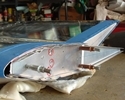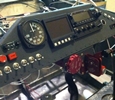


random user submitted photo
Wire size
6 posts
• Page 1 of 1
Wire size
I added up the current consumption of my radio, transponder, MGL E-1, F-2, lights, etc and the total is less than 3 amps. I'm trying to determine the wire size to supply the main power buss. The plans suggest 8 ga. but that seems really big.
Also, what's the current draw for the secondary ignition? What size fuse is required?
Thanks for any help.
Also, what's the current draw for the secondary ignition? What size fuse is required?
Thanks for any help.
Darick Gundy
Sonex #1646
N417DG
Taildragger, Aerovee, center stick, Prince P-Tip Prop
MGL E1, F2, V6 radio, Sandia Xponder, Reserve lift indicator (AOA), iFly 520
First flight! 10/21/2017
Sonex #1646
N417DG
Taildragger, Aerovee, center stick, Prince P-Tip Prop
MGL E1, F2, V6 radio, Sandia Xponder, Reserve lift indicator (AOA), iFly 520
First flight! 10/21/2017
-

Darick - Posts: 496
- Joined: Mon Aug 05, 2013 9:39 pm
- Location: PA
Re: Wire size
Darick,
Here is an excellent article on picking wire size:
http://www.aeroelectric.com/articles/wiresize.pdf
When you come up with 3 amps, is that steady state or when the com radio and transponder is transmitting? I would use the latter not only to ensure sufficient ampacity but to minimize losses. I think 3 amps sounds low. My LED nav lights and landing lights all use about .7A. That is nearly 3A right there. The LED strobes average .2A but they are zero for a long time with a burst of 5A.
Here is an excellent article on picking wire size:
http://www.aeroelectric.com/articles/wiresize.pdf
When you come up with 3 amps, is that steady state or when the com radio and transponder is transmitting? I would use the latter not only to ensure sufficient ampacity but to minimize losses. I think 3 amps sounds low. My LED nav lights and landing lights all use about .7A. That is nearly 3A right there. The LED strobes average .2A but they are zero for a long time with a burst of 5A.
Bryan Cotton
Poplar Grove, IL C77
Waiex 191 N191YX
Taildragger, Aerovee, acro ailerons
dual sticks with sport trainer controls
Prebuilt spars and machined angle kit
Year 2 flying and approaching 200 hours December 23
Poplar Grove, IL C77
Waiex 191 N191YX
Taildragger, Aerovee, acro ailerons
dual sticks with sport trainer controls
Prebuilt spars and machined angle kit
Year 2 flying and approaching 200 hours December 23
-

Bryan Cotton - Posts: 5535
- Joined: Mon Jul 01, 2013 9:54 pm
- Location: C77
Re: Wire size
The plans call for an 8 ga. from the voltage regulator to the main bus, however the attachment is via "fast-on". The largest fast-on will only take a 10 ga. wire which is what I used. The 10 ga. is plenty to handle the 20 amps put out by the alternator. The link Bryan sent was my source as well. also downloaded the "aeroelectric connection" book that I used exclusively to plan my wireing.
Here is the link to the book in pdf: http://www.aeroelectric.com/Book/AEC_R12A.pdf
Here is the link to the book in pdf: http://www.aeroelectric.com/Book/AEC_R12A.pdf
Bill Larson
N861SX
Sonex, polished, tail wheel, Generation 4 Jabiru 3300
N861SX
Sonex, polished, tail wheel, Generation 4 Jabiru 3300
- wlarson861
- Posts: 499
- Joined: Wed Dec 05, 2012 11:41 pm
Re: Wire size
I agree with Bryan and Bill around the book. It was a good read, although I will be the first to admit that electrical was my biggest challenge and I struggled at first. I recommend creating a peak usage excel chart (mine is shown below) if you have not yet done so. Find your total amps to ensure your systems will all be supported at peak and no breakers will pop. And that your total peak is below the 20 alternator output.
For the secondary, I planned on 7 amps with a 10 amp breaker.
For the secondary, I planned on 7 amps with a 10 amp breaker.
Building: [11323] Zenith 750 CruzerDuty27.5 / O-320 [Instagram Build Log: Zenith750CruzerSTOL]
N67LJ - Vans RV-9A #90504 (SOLD)
N83LJ - Sonex #0864 (SOLD)
https://rvpilotlife.wordpress.com/blog/home/
N67LJ - Vans RV-9A #90504 (SOLD)
N83LJ - Sonex #0864 (SOLD)
https://rvpilotlife.wordpress.com/blog/home/
-

jjbardell - Posts: 315
- Joined: Wed Feb 25, 2015 5:12 pm
Re: Wire size
Thanks for the tips and suggestions...it has helped me to move on. Sometimes roadblocks pop up and u need to step back, regroup, rethink from a different perspective.
Darick Gundy
Sonex #1646
N417DG
Taildragger, Aerovee, center stick, Prince P-Tip Prop
MGL E1, F2, V6 radio, Sandia Xponder, Reserve lift indicator (AOA), iFly 520
First flight! 10/21/2017
Sonex #1646
N417DG
Taildragger, Aerovee, center stick, Prince P-Tip Prop
MGL E1, F2, V6 radio, Sandia Xponder, Reserve lift indicator (AOA), iFly 520
First flight! 10/21/2017
-

Darick - Posts: 496
- Joined: Mon Aug 05, 2013 9:39 pm
- Location: PA
Re: Wire size
Have 10 ga. feeding my master 30 amp breaker with 40 amp in-line fuse on firewall side for short circuit protection. All my lighting, including landing and strobes are LED, and no power hungry instrumentation, so that has been quite adequate.
David A. Sonex TD, Camit 3300 with old style flywheel 17 amp alternator.
David A. Sonex TD, Camit 3300 with old style flywheel 17 amp alternator.
- DCASonex
- Posts: 936
- Joined: Mon Sep 12, 2011 8:04 pm
- Location: Western NY USA
6 posts
• Page 1 of 1
Who is online
Users browsing this forum: No registered users and 1 guest







